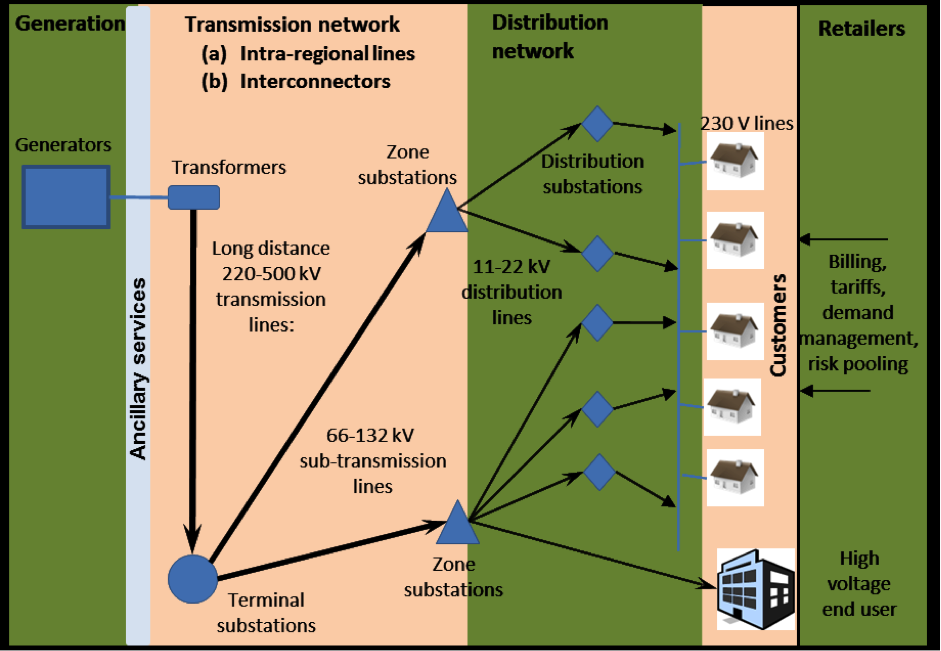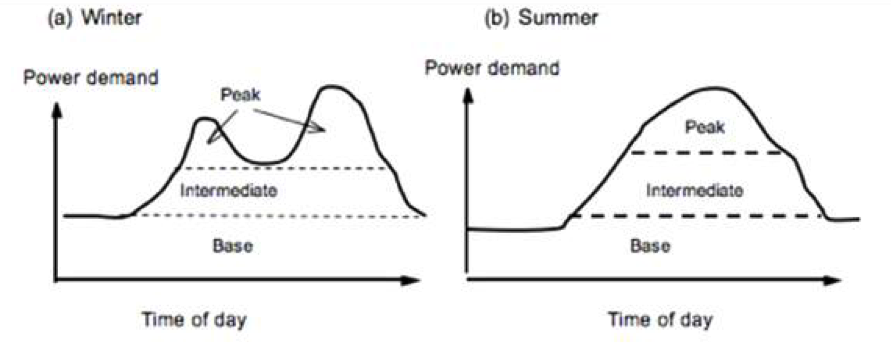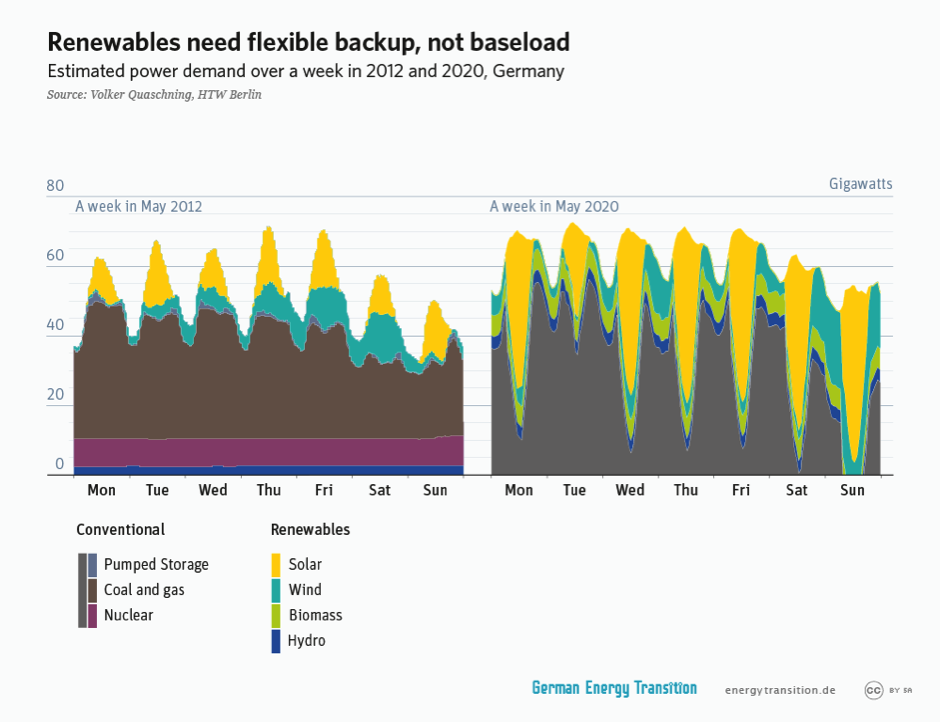As the uptake of renewable energy continues, solar and wind customers around the world are facing resistance from electricity utilities. The ‘Future of Utilities’ series aims to introduce various concepts to help explain the reasons behind the resistance, what it means for renewable energy generators and what the future holds for utilities, electricity customers and distributed generation owners.
This article delves into the concept of the electricity generation mix, which is at the heart of understanding how renewables fit into and are dramatically changing the face of electricity generation today.
What is the grid?
- Before we delve into that, however, let us first examine the nature of the electricity supply network (the ‘grid’) functions and how it’s structured.
- The electricity network is essentially a transportation system that takes power from generators and delivers it to the end users (residential and commercial). Physically, the grid consists of 6 main components:
- Generators
- Transformers: which convert electricity from the generators into a high voltage form that can be distributed
- High-voltage transmission lines: These are the ubiquitous strings of lines on steel lattice towers that cover large distances
- Substations: which convert high voltage to lower voltage for distribution in local areas
- Distribution network: The ‘capillary’ network of poles and wires that actually connects to end users
- Meters: which measure how much electricity is being used (or generated, in the case of distributed generation sources like roof top solar).
Source: Productivity Commission of Australia (pdf)
Historically, this entire infrastructure was planned, owned and managed by a single ‘utility’ (typically a public works department) that was responsible for regional electricity supply. While this is no longer the case today due to large size of grids in most countries, the word ‘utility’ has become entrenched in the minds of most electricity customers and belies the complexity of electricity supply networks of today.
However, as shown in the graphic above, electricity networks today are divided into generation, transmission, distribution, retailing and ancillary services (more on this later), all of which together operate in an electricity market with private and public companies competing to various degrees at each level of the supply chain.
In order to understand why the “utilities” are resisting distributed generation, it is important to first understand how renewable energy technologies affect this supply chain and where.
Centralised generation and base-load power plants
Note that the graphic above depicts centralised generation – the concept that large, centralised generators create electricity that is then distributed using a combination of high and low voltage lines before it reaches the end user. The model assumes a one-way flow of electricity and has worked well for over a 100 years in an age where large fossil fuel and nuclear plants were the only significant sources of electricity.
Under such a system, the mix of different power plant types used to generate electricity (called the ‘generation mix’) was historically based on a concept of base, intermediate and peak load generators. The graphic below shows how different generator types may supply electricity to meet demand on a typical summer or winter day.
Source: AREA New York (pdf)
Here, base-load generators (historically, large coal plants that could consistently generate a stable level of power) were made to generate the minimum level of power that was always required by the grid, while intermediate generators that could turn on and off (but relatively slowly) met most of the remaining demand. Finally, peak load generators (such as gas power plants) meet the remaining spikes in demand since they can quickly turn on and off.
Most renewable energy sources, however, are intermittent. If considered on an individual basis, no one renewable energy source (only solar or only wind) can provide the assured stability that a base-load generator does or the on-demand generation that a peak load generator provides. Thus, when intermittent sources like wind and solar energy first entered the market, it provided a challenge for market operators (who are responsible for choosing when generators can turn on and off).
Accommodating renewables in the generation mix
If grids have to accommodate intermittent sources, they have to prioritize the output of these generators at the expense of base-load generators. For low levels of intermittent generation, this was tolerable. This, combined with the fact that renewables could actually help with meeting peak demand was, in fact, the reason why utilities (particularly in Australia) were initially unperturbed when solar PV entered the electricity market.
However, the explosive growth in renewables is now gradually and noticeably reducing the minimum consistent level of power demand that base-load generators can generate. For a newly built coal power plant, this prospect is worrying as it cuts into profit margins and could even make base-load power plants completely unprofitable in the long run if base-load generators cannot run as they were designed – in continuous operation.
This situation is depicted in the graphic below which shows the generation mix in Germany today (on the left) and in a hypothetical future with high solar and wind penetration (on the right).
Source: Heinrich Böll Foundation
As can be seen above, solar and wind currently chip away only at the peak demand; however, with higher penetration, they dig into what was formerly considered base-load. Thus, integration of high-penetration renewables would necessarily require base-load generators to be replaced with a higher proportion of flexible generators.
Base-load generators – an obsolete idea?
However, as researchers at the University of New South Wales have pointed out in a recent study (pdf), the intermittency of different renewable energy technologies like wind, solar, geothermal, etc varies with technology (and therefore can be made smoother by selecting the right mix of technologies).
Moreover, the intermittency of some technologies like wind is actually lower when penetration is high. In other words, the power output of individual wind turbines may be intermittent (wind doesn’t always blow in one place all the time), but the power output of a large network of wind turbines spread across the country will be much more consistent over time as the wind is almost guaranteed to be blowing somewhere all the time. Hence, researchers at UNSW argue that high wind penetration could act almost like a base-load.
The situation is certainly different for solar PV, which cannot operate at night time and would add significant variation (as seen in the graphic above); however, this can be mitigated with the help of energy storage, which could absorb excess solar output when not needed and release it at night when demand is higher.
In any case, as it stands today, the prospect is truly troubling for generation companies (that have largely invested in base-load generators like coal and nuclear power plants). For generation companies with a more diverse mix of generation assets, the need for more flexible generators (such as gas power plants) to back-up renewable generation may provide opportunities in a familiar space. However, utilities are best positioned to take advantage of the change by actively investing in utility-scale renewable energy projects themselves. In fact, solar PV has already become more profitable at the utility scale than coal-powered plants themselves.
Nevertheless, utilities around the world continue to try and fight this change to their existing business model. In Australia, which has large coal- and gas-based generators and a large coal and mining lobby, utilities have tried everything from putting up barriers to entry for rooftop solar, to adding direct and indirect political pressure to stop government support for renewables. They have even been successful to some extent and the potential impact of the recent review of the Australian Renewable Energy Target is a case in point. Still, the overall market forces continue to act against base-load generators and it is only a matter of time before utilities adapt their business models to the coming change.
However, it is not just generation utilities that may have to change. Researchers and industry insiders alike are calling for a larger systematic rethink of the centralised generation model itself – more on that in our future articles.
Top image: Melbourne terminal substation, via Wikipedia
© 2014 Solar Choice Pty Ltd
- Future of Utilities – Part 1: The death of base-load generators - 11 September, 2014
- Sharp enters energy storage market with SmartStorage - 18 August, 2014
- Phinergy extends electric car range with metal-air battery technology - 13 August, 2014


